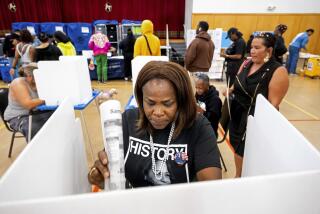The Electoral College
- Share via
The electoral college was first used in 1789 as a compromise between the election of president by popular vote and election by Congress. Under the electoral college system, no one actually votes for a candidate for president. Instead, voters select slates of electors committed to supporting their political party’s nominee.
*
For the record:
12:00 a.m. Nov. 10, 2000 For the Record
Los Angeles Times Friday November 10, 2000 Home Edition Part A Part A Page 3 Metro Desk 2 inches; 39 words Type of Material: Correction
Election facts--An Oct. 29 map switched the number of electoral votes for Maryland and the District of Columbia. Maryland has 10 and the district has three. A graphic on Sunday incorrectly stated that William Henry Harrison won the 1888 election. Benjamin Harrison was the winner.
How It Works
1. Political parties nominate electors at state conventions.
2. Registered voters select the presidential candidate
of their choice.
3. In each state, the candidate with the majority of popular votes receives the party’s electors.*
4. The electors vote for a president and a vice president. Votes are transmitted to the Senate and tallied at a joint session of Congress. A candidate needs 270 electoral votes to be elected 5. If no presidential candidate receives a majority of electoral votes, the House of Representatives selects the winner from the top three vote-getters.
By the Numbers
*
* 54: Most electoral votes held by one state (California)
*
* 3: Fewest electoral votes (Alaska, Del., D.C., Mont., N.D., S.D., Vt., Wyo.)
*
* 515: Largest electoral vote margin of victory (Franklin D. Roosevelt over Alfred Landon,
523 to 8, in 1936)
*
* 1: Smallest electoral vote margin of victory (Rutherford B. Hayes over Samuel J. Tilden, 185 to 184, in 1876)
*
Taking the Pledge
Although there is no federal law binding electors to candidates, about half the states have laws requiring electors to vote as pledged. In California, a faithless elector can be fined $1,000 and sent to prison for up to three years.
*
Election Calendar
Tuesday: Election day.
Dec. 18: Electoral college members cast their votes in their respective state capitals.
Jan. 6, 2001: The vice president reads the votes before both houses of Congress.
Jan. 20, 2001: New president and vice president are sworn in to office.
*
Losing but Winning
Three men lost the popular vote but, through the electoral college process, won the White House. Those presidents and the percentage of the popular vote they received:
*
*--*
John Quincy Adams 30.92% 1824 Rutherford B. Hayes 47.95% 1876 William Henry Harrison 47.82% 1888
*--*
*
Web Sites
Web sites run by the National Archives and Records Administration and the Federal Election Commission have voluminous information about the electoral college and its role in American history:
https://www.nara.gov/fedreg/elctcoll/index.html
https://www.fec.gov/pages/ecmenu2.htm
Sources: Congressional Quarterly, Federal Election Commission, National Archives and Records Administration, Associated Press
Compiled by JOHN TYRRELL / Los Angeles Times
--- UNPUBLISHED NOTE ---
This story has been edited to reflect a correction to the original published text. The ‘electoral system’ was first used in 1789, not 1804. Furthermore, Congressional Quarterly’s Guide to the U.S. Elections (3rd edition) states that “The term ‘electoral college’ itself does not appear in the Constitution. It was first used unofficially in the early 1800s and became the official designation for the electoral body in 1845.” In 1804 the Twelfth Amendment was added to the Constitution “that substantially altered the method of electing the president.” The electoral process described in this graphic reflects the changes instituted when the 12th Amendment was ratified in 1804, and not in the 1789 election of George Washington.
--- END NOTE ---
More to Read
Get the L.A. Times Politics newsletter
Deeply reported insights into legislation, politics and policy from Sacramento, Washington and beyond. In your inbox twice per week.
You may occasionally receive promotional content from the Los Angeles Times.









